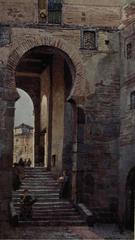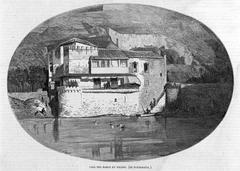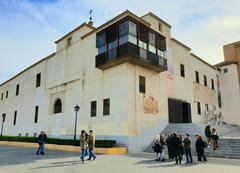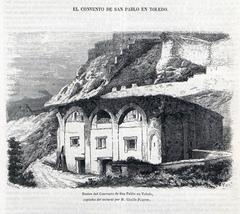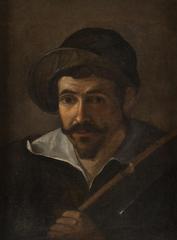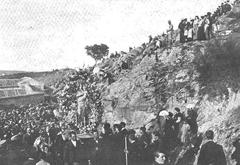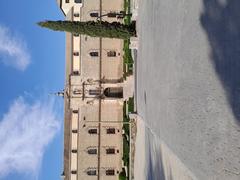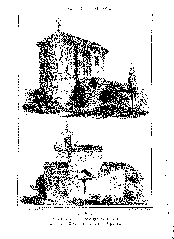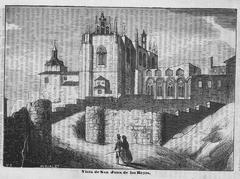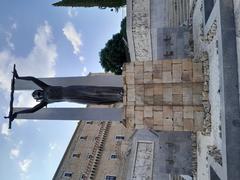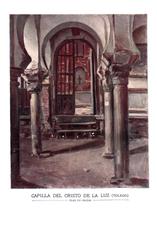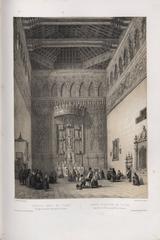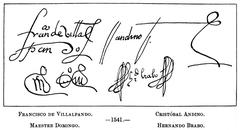
Visiting Monasterio de Santo Domingo el Real, Toledo, Spain: Tickets, Hours, and Tips
Date: 04/07/2025
Introduction
Situated in the heart of historic Toledo, the Monasterio de Santo Domingo el Real is a monument of religious devotion, royal patronage, and architectural beauty. Founded in 1364 by Inés García de Meneses, this Dominican convent encapsulates centuries of spiritual tradition and artistic evolution. Its role as a royal sanctuary, a burial place for Castilian nobility, and a center of female monastic life makes it one of Toledo’s most captivating historical sites. This comprehensive guide covers the monastery’s history, architectural highlights, visiting hours, ticket info, accessibility, and practical travel tips, ensuring a rewarding visit to this iconic Spanish landmark (Conventos de Toledo; Guía Javi; Dominicos.org).
Table of Contents
- Historical Background
- Royal Connections and the “Real” Designation
- Architectural and Artistic Heritage
- Spiritual and Cultural Importance
- Visiting Information
- Visitor Experience
- Nearby Attractions
- Frequently Asked Questions (FAQ)
- Summary and Visitor Tips
- References
Historical Background
The Monasterio de Santo Domingo el Real was established during the turbulent Castilian Civil War, with support from King Pedro I of Castile and authorization from Archbishop Gómez Manrique. Inés García de Meneses, a noble widow, donated her residence to found what became the first Dominican nunnery in Toledo. The monastery’s archives preserve important documentation and correspondence from the period, marking it as a place of memory for Castilian nobility (Conventos de Toledo; Guía Javi; Wikipedia).
Royal Connections and the “Real” Designation
The convent’s royal connections are extensive. Notable residents include María de Castilla (daughter of Pedro I) and Teresa de Ayala (noblewoman and prioress), whose tombs, alongside those of royal infants Sancho and Diego de Castilla, are integral to the monastery’s status as a royal sanctuary. The “el Real” designation references both its royal patronage and Dominican identity (Destino Toledo; Wikipedia).
Architectural and Artistic Heritage
Structural Evolution
The convent has evolved architecturally over centuries. The original Gothic church (1396) was replaced in the 16th century, and today’s façade—designed by Juan Bautista Monegro circa 1612—is a Renaissance masterpiece featuring a portico with four Tuscan columns and symbolic reliefs (Conventos de Toledo). The Claustro de la Mona, a Renaissance cloister, is recognized as a Bien de Interés Cultural for its harmonious design and tranquil gardens (Catálogo Patrimonio Cultural Castilla-La Mancha).
Interior Treasures
Highlights include:
- Early Spanish domes by Diego Velasco de Ávila
- 16th-century retablos dedicated to St. John the Baptist
- 18th-century gilded main altarpiece (Capilla Mayor), sponsored by the Rivera family
- Choir stalls and funerary monuments featuring heraldic and sculptural details
The monastery also houses an important collection of polychrome altarpieces, devotional paintings, textiles, manuscripts, and liturgical objects, many of which were commissioned or donated by noble patrons (Dominicos.org; Objetivo Toledo).
Artistic and Cultural Significance
The monastery’s role as a center of female Dominican spirituality is underscored by the presence of noble and royal women who commissioned artworks, maintained archives, and contributed to Toledo’s cultural life. Royal burials and the preservation of tombs emphasize the site’s dynastic importance (Dominicos.org; Objetivo Toledo).
Spiritual and Cultural Importance
Santo Domingo el Real served as a spiritual retreat for generations of noblewomen, including Santa Beatriz de Silva, founder of the Order of the Immaculate Conception. The monastery is embedded in local legend and is a focal point during Holy Week celebrations (Destino Toledo; Toledo Guiaturistica y Cultural).
Visiting Information
Visiting Hours and Tickets
- Open: Select days, typically Tuesday to Sunday, 10:00 AM – 2:00 PM (closed Mondays and religious holidays), with additional hours during special events. Always check the official tourism website or contact the monastery for up-to-date hours.
- Tickets: General admission is often free during open days; donations are welcomed. Special events and guided tours may require advance booking and a small fee.
Guided Tours and Special Events
Guided tours—available by request or during cultural events—offer in-depth perspectives on the monastery’s history, architecture, and art. The monastery hosts significant processions during Holy Week and participates in Toledo’s heritage routes (Toledo Guiaturistica y Cultural; Dominicos.org).
Accessibility and Travel Tips
Due to its medieval layout, some areas may be difficult for visitors with mobility concerns, though ramps and adapted pathways are present in select sections. Comfortable footwear is recommended, as Toledo’s streets are cobbled and hilly. The monastery is a short walk from the city center and close to public transport. Contact staff ahead for accessibility details.
Visitor Experience
Photography is permitted in most areas (no flash or tripods). Modest clothing is expected, and visitors should maintain a respectful demeanor, especially in spaces reserved for the cloistered community.
Nearby Attractions
The monastery’s central location makes it ideal for combining with other Toledo highlights such as:
- Toledo Cathedral
- Alcázar of Toledo
- Church of Santo Tomé
- Jewish Quarter
Local cafés and shops offer regional specialties, including marzipan and Manchego cheese.
Frequently Asked Questions (FAQ)
What are the visiting hours?
Hours vary; check the official website before your visit.
Are tickets required?
Most visits are free or require a modest donation. Guided tours may require advance booking.
Is the monastery wheelchair accessible?
Some areas have ramps, but historic sections may be challenging for wheelchair users.
Are guided tours available?
Yes, especially during cultural events or upon request.
Is photography allowed?
Photography is allowed in most areas without flash or tripods.
What’s the best time to visit?
Weekday mornings or late afternoons are quieter and offer optimal lighting for photography.
Summary and Visitor Tips
The Monasterio de Santo Domingo el Real is a living monument combining Gothic and Renaissance architecture, royal tombs, and centuries of Dominican spirituality. Plan your visit by checking current hours and booking guided tours if possible. Respect the contemplative atmosphere, wear comfortable shoes, and take time to explore nearby historical sites. For the latest updates, audio guides, and special event info, download the Audiala app and follow us on social media.
References
- Conventos de Toledo
- Guía Javi
- Wikipedia
- Destino Toledo
- Toledo Guiaturistica y Cultural
- Dominicos.org
- Catálogo Patrimonio Cultural Castilla-La Mancha
- Toledo Olvidado
- Turismo Castilla-La Mancha
- Objetivo Toledo




